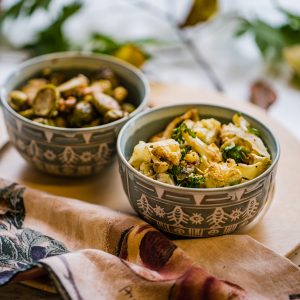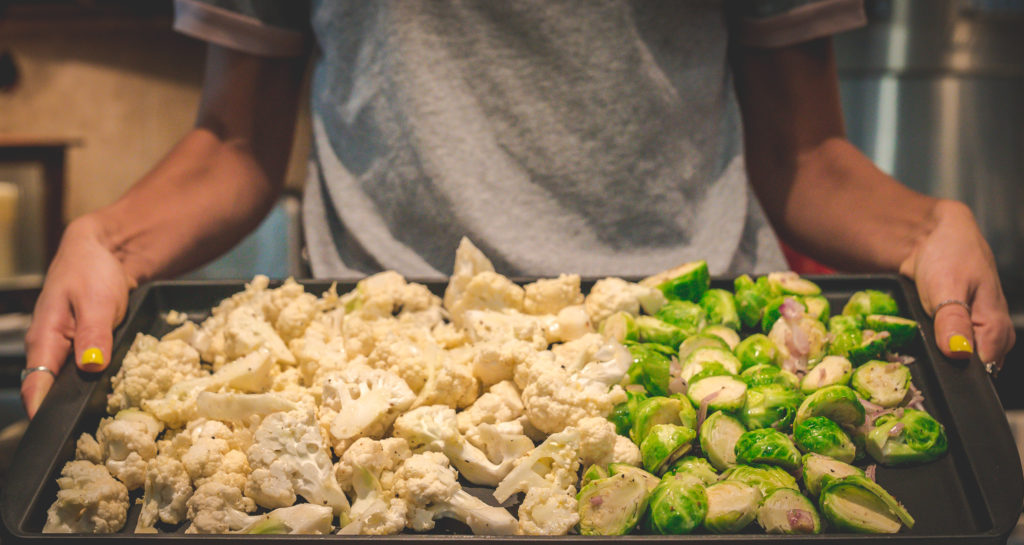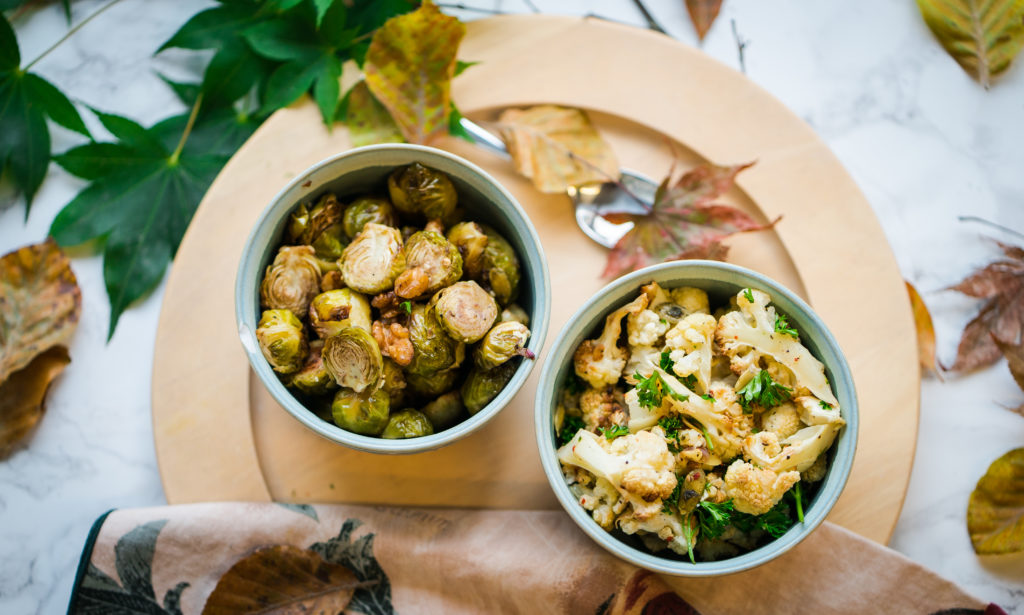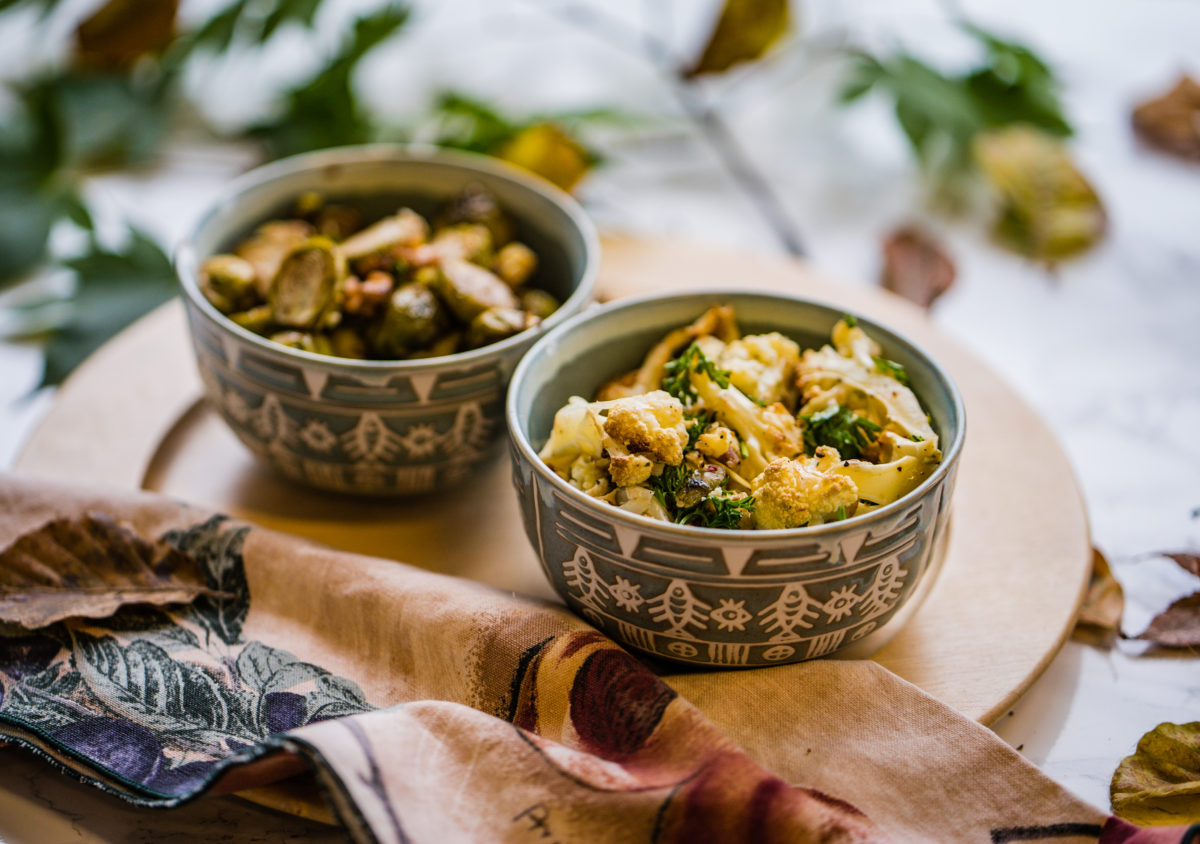I’m always on the lookout for holiday recipes that are easy to prepare… and I’m thrilled to share three of my all-time favorites with you here!
These side dishes are a cinch to whip up. And even better — all three recipes are loaded with nutrient-dense veggies you (and your bones) can feel good about eating. Don’t be surprised if you find yourself craving them all season long!
Balsamic Brussels Sprouts
Brussels sprouts seem to be a staple of Thanksgiving and festive dinners. That said, you may not be a big fan of them — I know I wasn’t!
That is, until AlgaeCal’s COO, Vivian, introduced me to this incredibly delicious Brussels sprouts recipe. So this is for you, Viv!
Adding coarsely chopped nuts (try toasting them!) and aged balsamic vinegar is what sets this recipe apart. And if you want to add a bit more umami (savory taste), pan-frying some chopped bacon will elevate this dish even more.
Brussels sprouts boast some major health benefits, too, and have been linked with unique benefits for DNA protection.
Brussels sprouts have also been used to determine the impact on thyroid function, as cruciferous vegetables are often not recommended for those with thyroid disease. One preliminary study had participants eat 150 grams of cooked Brussels sprouts daily for 4 weeks, along with a normal diet. The researchers found no effect on thyroid function, which suggests that while further studies are needed, Brussels sprouts can be beneficial without putting your thyroid gland at risk.
In addition, 1 cup of Brussels sprouts contains:
- 38 calories
- 125% DV (Daily Value) of Vitamin C
- 195% DV of Vitamin K
- 10% DV of Potassium
- 15% DV of Manganese
- 87 mg of omega 3 fatty acids

Balsamic Brussels Sprouts
Ingredients
- 1 1/2 lb Brussels sprouts cut in half through the core
- 2 tbsp olive oil extra virgin
- 1/4 cup pecan coarsely chopped
- 1/4 cup walnut coarsely chopped
- 1-2 tbsp aged balsamic vinegar
- 1 shallot finely chopped
- salt to taste
- pepper to taste
- bacon bits optional
- capers optional
- parmesan shredded, optional
Instructions
- Preheat oven to 400 degrees F.
- Clean and trim Brussels sprouts, then mix Brussels sprouts and chopped shallot in a medium-sized bowl and toss with olive oil, salt and pepper.
- Pour onto a baking sheet and spread evenly.
- Bake uncovered for 20 minutes. Then rotate and flip and bake for another 10-15 minutes. *Rotating and flipping helps them brown evenly so they are crispy on the outside and tender on the inside.
- Take out the pan and pour the Brussels sprouts into a medium-sized bowl.
- Add the aged balsamic vinegar and chopped nuts. Mix.
- Check for seasoning and serve!
Notes
Nutrition

Roasted Cauliflower with Lemon
Cauliflower is such a versatile vegetable. Plus, it’s considered one of the healthiest foods on Earth! It’s part of the cruciferous vegetable family (along with kale, Brussels sprouts, and broccoli). Research suggests it’s an excellent source of antioxidants, vitamins, and minerals.
Cauliflower has been linked to cancer prevention, as well as weight loss due to its extremely low calorie content.
In fact, 1 cup of raw cauliflower contains:
- 25 calories
- 77% daily value (DV) of vitamin C
- 9% DV of phosphorous
- 8% DV of manganese
- 14% DV of folate
- 11% DV of vitamin B6
- 20% DV of vitamin K
- 37 mg of omega 3 fatty acids
- And close to 0 g of sugar, sodium, or fat!

Roasted Cauliflower with Lemon
Ingredients
- 2 tbsp olive oil divided
- 1 large head cauliflower chopped
- 1/4 cup pumpkin seeds raw, shelled
- 1/4 cup parsley chopped, fresh
- 1/2 tsp red pepper flakes crushed
- 1 tbsp lemon juice fresh
- salt to taste
- pepper to taste
Instructions
- Preheat oven to 400 degrees F.
- Clean and trim your cauliflower and chop into florets.
- In a medium-sized bowl mix cauliflower, olive oil, salt and pepper.
- Pour onto baking sheet evenly.
- Bake uncovered for 20 minutes. Then rotate and flip and bake for another 10-15 minutes. *Rotating and flipping helps them brown evenly so they're crispy on the outside and tender on the inside.
- Take out the pan and put the cauliflower into a medium-sized bowl.
- Add the chopped parsley, olive oil, pumpkin seeds, and additional salt and pepper, red pepper flakes, and lemon juice. Mix it all together.
- Check for seasoning and serve!
Notes
Nutrition

Healthy Holiday Stuffing
If you’re like me, your childhood memories of Thanksgiving dinners include a stuffing your mom prepared from a box. I admit it… it was my favorite part of the meal!
But those packaged stuffings have never exactly been good for you. They tend to be high in calories and refined carbohydrates, and low in fiber and nutrients. (Check the nutrition panel of any of the popular brands next time you’re at the grocery store.) That’s because their main ingredients are things like wheat flour, vegetable oil, and sugar. Even most traditional homemade stuffings are full of bread and white rice… foods that contribute to the chronic, low-grade inflammation that promotes bone loss.
That’s why we created this healthy version of the stuffing you grew up loving! Unlike traditional and packaged stuffings, this one is loaded with nutrient-dense veggies, like parsnip. Just 1 cup of parsnip contains more than 6 grams of fiber, plus significant amounts of calcium, magnesium, phosphorous, potassium, vitamin C, and more.
Just like with carrot, roasting brings out the parsnip’s natural sweetness… which beautifully complements the savory onion and herbs in this recipe. Feel free to experiment with your favorite seasonings, and let us know what you think in the comments section below!

Healthy Holiday Stuffing
Ingredients
- 4 cups parsnip chopped
- 1 cup carrot chopped
- 1 cup yellow onion chopped
- 1 1/4 cups mushrooms chopped
- 4 cloves garlic minced
- 1 tbsp butter (or coconut oil)
- fresh or dried thyme to taste
- fresh or dried sage to taste
- salt and pepper to taste
Instructions
- Preheat oven to 400 degrees F.
- Line a baking sheet with parchment paper. Arrange the chopped parsnip, carrot and onion separately from each other. (Depending on the size of your baking sheet, you may need a second one to hold all the veggies.)
- Place the baking sheet on the middle oven rack, and roast for 30 minutes. (Check after 20 minutes. If the onion is cooking faster, remove it from the sheet and transfer it to a bowl. Stir the remaining vegetables on the baking sheet and return them to the oven.)
- Meanwhile, melt the butter (or coconut oil) in a skillet over medium heat. Saute the garlic until fragrant but not browned (1-2 minutes). Add mushrooms and cook, stirring often, until tender and just starting to brown (5-6 minutes). Remove from heat.
- When the roasted vegetables are cooked, transfer them and the mushrooms into a food processor. Add the thyme, sage, salt and pepper.
- In the food processor, quickly “pulse” the vegetables so they’re blended but still chunky.
- Taste and add more thyme, sage, salt and/or pepper, if you like.
Notes
Nutrition
Thanksgiving Sides Last Note
What are you planning to make this Thanksgiving? Share your favorite recipes in the comments below!





Kim
November 18, 2017 , 7:37 amSounds delicious…we will be trying both.
Thank you. This is a very nice service.